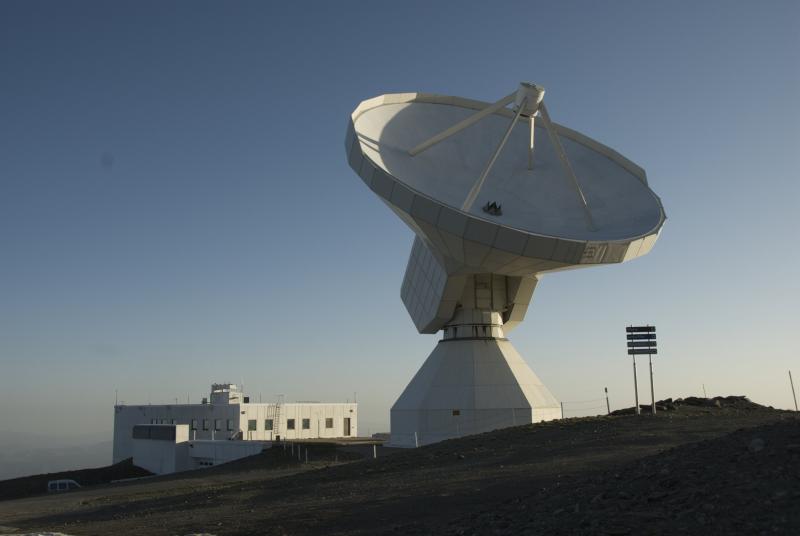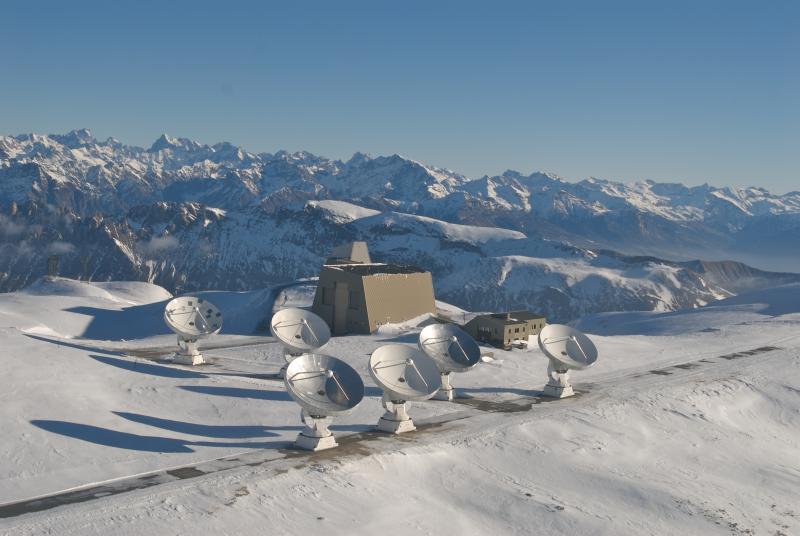IRAM operates 2 telescopes:
- 30-metre Telescope: Pico Veleta, Granada, Spain
- Plateau de Bure Interferometer (NOEMA Interferometer): Hautes-Alpes, France
Pico Veleta, Granada, Spain:
The 30-m telescope located at an altitude of nearly 3000m on the Pico Veleta in the Spanish Sierra Nevada has been designed with a surface accuracy and a pointing capability for observations in the atmospheric windows at 3, 2 and 1 mm. Occasionally the telescope is even used at 0.8 mm during particularly favourable atmospheric conditions.
While other telescopes exist in Europe that can observe in the 3mm atmospheric window, e.g. the 100m telescope in Germany, the Onsala telescope in Sweden, and the Metsahovi telescope in Finland, and while European groups operate (sub-)mm-telescopes like APEX in Chile and the JCMT in Hawaii, the IRAM 30-m telescope is by far the most sensitive in its wavelength range. It offers unique observing capabilities through the simultaneous availability of several low-noise heterodyne receivers (EMIR), an 18-channel heterodyne array (HERA) and a 119 channel bolometer array (MAMBO). The heterodyne receivers can be connected to a variety of analogue and digital backends that allow spectroscopic studies at resolutions between 3.3 KHz and 4 MHz. One of the backends is capable of making cross correlations, a feature which is used for polarization observations.
The telescope is also equipped with a Mark IV VLBI terminal, and VLBI experiments at 3, 2 and 1.3mm wavelengths have successfully been carried out in recent years. By combining the 30m-telescope with the 15-m diameter antennas on the Plateau de Bure Observatory, it has indeed been possible to detect for the first time fringes with high signal/noise ratio in a VLBI experiment at 1.3mm. The 30-m telescope is also very well suited and often used for complementing interferometer maps with short spacing information.
Plateau de Bure Interferometer: Hautes-Alpes, France:
 The Plateau de Bure Interferometer (NOEMA Interferometer) started in 1990 as a 3-element array. It is located at 2550m altitude in the French Alps, near Gap. Since then, 3 more 15-m diameter antennas have been added, and today all 6 telescopes are equipped with low-noise heterodyne receivers for the 3mm, 2mm, 1mm and 0.8mm atmospheric windows. The SSB receivers provide a contiguous bandwidth of 4 GHz in each polarization. There is at present no other interferometer on the Earth that offers the same sensitivity at these wavelengths. With baselines up to 768 meters (in east-west direction) it allows sensitive imaging at sub-arcsecond resolution (0.2-0.3 arcsec at 1.2mm wavelength).
The Plateau de Bure Interferometer (NOEMA Interferometer) started in 1990 as a 3-element array. It is located at 2550m altitude in the French Alps, near Gap. Since then, 3 more 15-m diameter antennas have been added, and today all 6 telescopes are equipped with low-noise heterodyne receivers for the 3mm, 2mm, 1mm and 0.8mm atmospheric windows. The SSB receivers provide a contiguous bandwidth of 4 GHz in each polarization. There is at present no other interferometer on the Earth that offers the same sensitivity at these wavelengths. With baselines up to 768 meters (in east-west direction) it allows sensitive imaging at sub-arcsecond resolution (0.2-0.3 arcsec at 1.2mm wavelength).
The signals from the 6 antennas are processed by two IRAM-developed digital correlators, which allow a large variety of observing modes and the possibility to phase up all 6 antennas for VLBI experiments. Global VLBI experiments at 3mm wavelength together with the American VLBA and a number of European telescopes are performed twice a year. VLBI observations at 1.3mm were performed with the 30m telescope, and in the longer term experiments are planned that also use the ALMA antennas in Chile. A major upgrade has been carried out that has transformed the Plateau de Bure Interferometer into a new qualitatively different and much more powerful instrument, the NOEMA Interferometer. The project consisted of doubling the number of 15m antennas (from 6 to 12), increasing the total IF of the receivers from 8 to 32 GHz, and extending the East-West baseline from 0.8 to 1.6km. Together with the IRAM 30-meter telescope, the enhancement provides the scientific community full access to all of the millimetre windows, from about 70 to 375 GHz, in the northern hemisphere, with a unique combination of two complementary facilities.
View IRAM PV in a larger map |
View NOEMA in a larger map |
Contact:
Roberto Neri
e-mail: neri [at] iram [dot] fr
IRAM
300 rue de la Piscine,
Domaine Universitaire
38406 Saint Martin d'Hères
France
website PV
website NOEMA
|